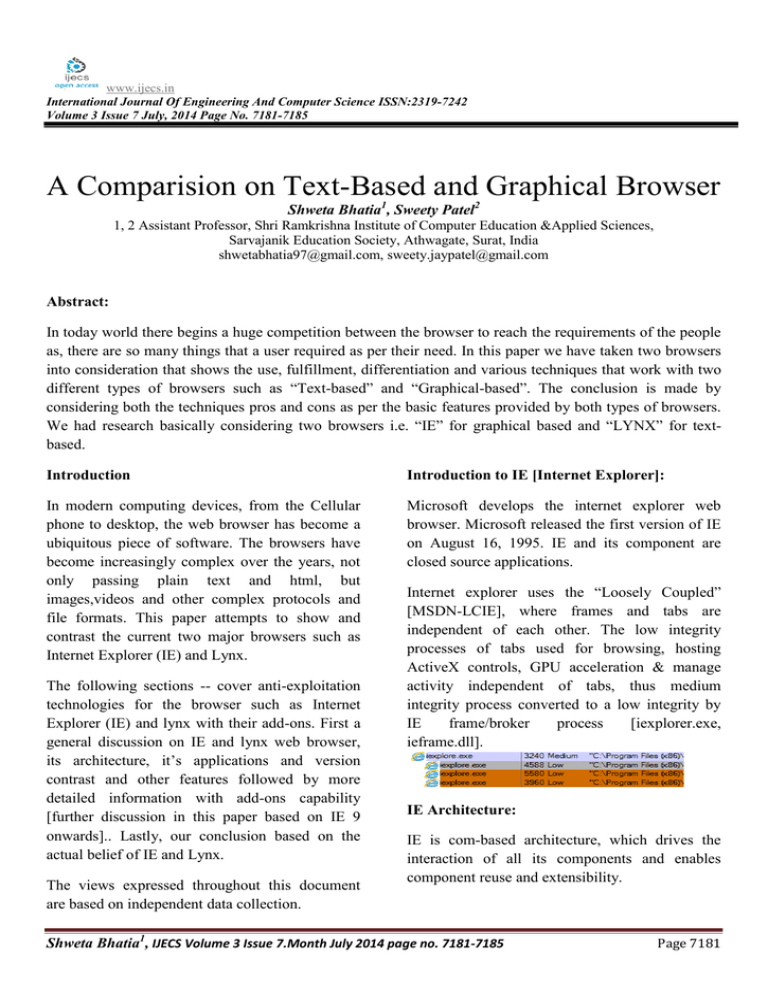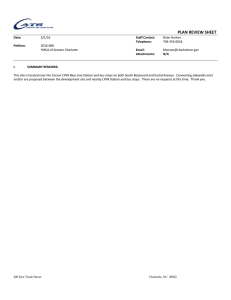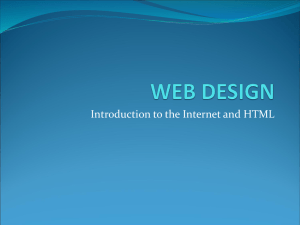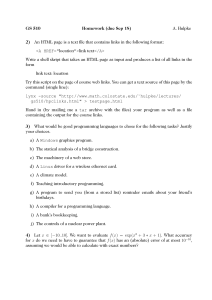www.ijecs.in International Journal Of Engineering And Computer Science ISSN:2319-7242
advertisement

www.ijecs.in
International Journal Of Engineering And Computer Science ISSN:2319-7242
Volume 3 Issue 7 July, 2014 Page No. 7181-7185
A Comparision on Text-Based and Graphical Browser
Shweta Bhatia1, Sweety Patel2
1, 2 Assistant Professor, Shri Ramkrishna Institute of Computer Education &Applied Sciences,
Sarvajanik Education Society, Athwagate, Surat, India
shwetabhatia97@gmail.com, sweety.jaypatel@gmail.com
Abstract:
In today world there begins a huge competition between the browser to reach the requirements of the people
as, there are so many things that a user required as per their need. In this paper we have taken two browsers
into consideration that shows the use, fulfillment, differentiation and various techniques that work with two
different types of browsers such as “Text-based” and “Graphical-based”. The conclusion is made by
considering both the techniques pros and cons as per the basic features provided by both types of browsers.
We had research basically considering two browsers i.e. “IE” for graphical based and “LYNX” for textbased.
Introduction
Introduction to IE [Internet Explorer]:
In modern computing devices, from the Cellular
phone to desktop, the web browser has become a
ubiquitous piece of software. The browsers have
become increasingly complex over the years, not
only passing plain text and html, but
images,videos and other complex protocols and
file formats. This paper attempts to show and
contrast the current two major browsers such as
Internet Explorer (IE) and Lynx.
Microsoft develops the internet explorer web
browser. Microsoft released the first version of IE
on August 16, 1995. IE and its component are
closed source applications.
The following sections -- cover anti-exploitation
technologies for the browser such as Internet
Explorer (IE) and lynx with their add-ons. First a
general discussion on IE and lynx web browser,
its architecture, it’s applications and version
contrast and other features followed by more
detailed information with add-ons capability
[further discussion in this paper based on IE 9
onwards].. Lastly, our conclusion based on the
actual belief of IE and Lynx.
The views expressed throughout this document
are based on independent data collection.
Internet explorer uses the “Loosely Coupled”
[MSDN-LCIE], where frames and tabs are
independent of each other. The low integrity
processes of tabs used for browsing, hosting
ActiveX controls, GPU acceleration & manage
activity independent of tabs, thus medium
integrity process converted to a low integrity by
IE
frame/broker
process
[iexplorer.exe,
ieframe.dll].
IE Architecture:
IE is com-based architecture, which drives the
interaction of all its components and enables
component reuse and extensibility.
Shweta Bhatia1, IJECS Volume 3 Issue 7.Month July 2014 page no. 7181-7185
Page 7181
The com has an extension capabilities in IE are
categorized into 3 major extensions.
-
Browser extensions
Content extensions
Hosting and Reuse
A Bowser extension is not directly related to the
viewable content of web pages. It includes
features such as Shortcut menu extensions,
Custom toolbars, Explorer bars and Browser
Helper Objects [BHO].
The Content extensions invoked specifically by IE
content [shdocvw.dll], which includes ActiveX
controls, Binary behaviors and Active documents.
By hosting and reusing the IE components as a
part of your own browser or add rich rendering
and internet capabilities.
Layout Engine: Trident [also known as
MSHTML] is the layout engine for various
versions of IE. It is an OLE Active Document
Object that represents IE’s layout, rendering and
editing engines. This is what IE uses to display
web pages [mshtml.dll][5].
Application of IE:
Above 5.0 version of trident or IE support various
applications such as:
API update supports for web standards. Smart
Screen Filter offers anti-phishing protection,
application
reputation
and
anti-malware
protection.
IE 11:
This version helps user to interact with next
generation of web apps, games, and media,
through following key features:
1.
2.
3.
4.
5.
6.
Perfect to touch
Pinned sites
Seamless integration
Click to call
Syncing across the devices
Do Not Track(DNT) exceptions
IE 11 is optimized to support all of the popular
web standards, to offer premier security and to
provide new and updated developer tools.It’s
including advanced feature for developer and IT
professional too thanever before,
1.
2.
3.
4.
5.
6.
7.
Enhanced Protocol Mode [EPM]
WebGL
Canvas 2D L2 extensions
Full screen API
CSS flexible box layout model
Improved HTML5 video
Using F12 developer tools
AOL
explorer,Limewire,Lunascape,Neoplanet,
Google talk,Green browser, Real Networks etc.
What’s new with IE 10 and 11?
IE 10:
Introduction to LYNX:
This version continues to provide key security and
performance feature as in earlier version of
browser with some add-ons such as:
LYNX developed by Montulli,Grobe&Rezac
team. Lynx is built in C language &its text based
browser. Its first version launched is 2.0.10.
Support of new standards like HTML5,CSS3 and
SVG to provide developers with new featured
facilities. Line of business applications that
require legacy ActiveX controls can use IE for the
desktop.Enhanced protected mode is used to
restrict ability of attackers to access sensitive
information in personal and corporate world.
Clicking on link provides keep you in same
browsing experience to follow the links.
Administration control is given to take decision
about how links get opened. Indexed Database
It’s one of the open source browser. Its fast, no
frills, plain text browser, predates www yet still in
Shweta Bhatia1, IJECS Volume 3 Issue 7.Month July 2014 page no. 7181-7185
Page 7182
wide use. It’s having small but complex codebase.
It’s followed by support of Gopher protocol, but
now support was grafted on www protocol,
making lynx pure web browser. Other protocol
supports are Http, IPv6, SSL, NNTP and FTP.
LYNX Architecture:
Lynx by its nature has an attribute that makes it
particularly appealing to people with certain
disabilities, because it strips down a webpage to
its most basic, GUI-Less state, & can be
completely navigable by keyboard[4].
1. Lynx had follow Incremental Process
model and resulted in system composed of
small fragments of code with no. coherent
overall structure, contractedly much of
code is on low-level that increase its
complexity.
2. The “libgnutls” library provides optional
support for secure protocols.
3. The “Curses” library is used to display &
navigate information on character cell
terminals.
Broswer Core
Data Persistence
User Interface
Browser Engine
Rendering Engine
wwwlib
Security
seS
JavaScr
ipt
interpr
eter
XML
Parse
r
Curs
es
Display Backend
4. Due to Lynx’s text-only nature- the
rendering engine outputs web pages in
linear form rather than attempting to
layout elements at appropriate co-
ordinates, and the user interface relies
dealing with menus, widgets and mouse
events.
5. Lynx does not contain JavaScript
interpreter or Xml parser as they are
modern feature not supported yet.
Applications of LYNX:
Various applications supported by Lynx browser
are:
An Amiga part made in 1995, Robotics support,
Remote access technologies: such as Telnet and
SSH.
Latest tablet supporting lynx: Lenovo IdeaTab K3.
What’s new to LYNX?
1. Lynx web browser error is the
Hexadecimal format of the error caused.
This is common error code also used by
windows.
2. Lynx also act as text-to-speech application
for usually impaired people & can power
refreshable Braille display. It supports
more than 200 configurable options too[3].
3. Release 2.8.7 (onwards) contains many
bug fixes & new features. For example:
the ability to save the current browsing
session has been added. This version also
offers improved support for secured SSL,
HTML interpretation &Cookies [4].
4. Lynx also uses for :
a. Testing web browser for logical
structure for search engines.
b. Testing web pages for accessibility
to screen readers.
c. Fast, safe access to text base web
sites.
Lynx is definitely not for end users. It’s pros who
either do not have any GUI support or for those
who are still working on legacy systems that do
not support GUI browser.
Lynx Point to cover: the text-based lynx, took
just 1min on solaries to load the 70mb files.
Shweta Bhatia1, IJECS Volume 3 Issue 7.Month July 2014 page no. 7181-7185
Page 7183
Differentiate Browser functionality and
Performance [7].
Developer
Average
Market
Share
Cost to
User
Open
Source?
Download
Page
Software
License
Languages
Current
Layout
Engine
IE
Microsoft
18%
Lynx
Montulli, Grobe,
Rezac, et al.
--
$0
$0
No
Yes
(microsoft.com)
(lynx.isc.org)
Proprietary
Spanish
Trident /
WebGL
GPL
Spanish
built-in
Performance:
Overall
Performance
Rankings
Java Script Speed
IE
5th out of 5
Lynx
--
6306
Page
Zooming
Pop-up
Blocking
Tabbed
Browsing
Tabbing
Navigation
Text-toSpeech
Voice
Control
Browser
Features
Auto Updater
Downloads
Form Input
Password
Management
Per-site
Security
Configuration
Privacy Mode
Search
Engine
Toolbar
Bookmarks
Yes
No
Yes
No
Yes
No
Yes
No
Yes
No
Yes
No
IE
Lynx
Yes
Yes
Yes
Yes
No
No
No
No
Yes
No
Yes
Yes
No
No
Yes
Yes
--
MILLISECONDS
DOM Selection
Speed
CSS Rendering
Speed
Page Load Times
CPU Usage
Browser Cache
Performance
Features:
Accessibility
Features
Access Keys
Ad Filtering
Caret
Navigation
Full-text
History
Search
Incremental
Finding
137
793
Support:
--
JavaScript
Support
----
DHTML
DOM 1
ECMA Script 3
JavaScript
Rich Editing
XML Http
Request
XPath
MILLISECONDS
4 SECONDS
18.1
2 SECONDS
IE
Lynx
Yes
Yes
Yes
No
No
No
Yes
No
Yes
--
MILLISECONDS
No
IE
Yes
Yes
Yes
Yes
Yes
Yes
No
No
No
No
No
No
Yes
No
Web
Technology
Support
CSS2.1
LINKs
SMIL
VML
Shweta Bhatia1, IJECS Volume 3 Issue 7.Month July 2014 page no. 7181-7185
Lynx
IE
Yes
No
Yes
Yes
Lynx
No
Yes
No
No
Page 7184
XSLT
Frames
Yes
Yes
Mobile
Technology
Support
No
Yes
IE
No
Plugins and
Syndicated
Content
Support
ActiveX
Atom
Gears
Java
Other Web
Feed
RSS
Image
Format
Supported
GIF
JPEG
PNG
No
IE
Lynx
Yes
Yes
Yes
Yes
Yes
No
No
No
No
No
Yes
No
Protocol
Support
data:URI
EV
Gopher
IDN
NNTP
(Usenet)
Proxy
Possibilities
FTP
HTTP
IPv6
SSL
Lynx
IE
No
No
Yes
No
Yes
Yes
No
Yes
Yes
Yes
Yes
Yes
Yes
Yes
Yes
IE
Yes
Yes
Yes
References:
Lynx
Yes
Yes
No
Yes
No
Lynx.The rendering engine is responsible for
performing many complex, error-prone task such
as parsing HTML and executing JavaScript.It will
be interesting to observe how the web browser
domain adaptsto support many different
functionalities and speed of the rendering process.
We have also observed several interesting
differentiation of two browsers IE and Lynx such
as performance, accessibility features, browsers
features, JavaScript support, web-technology
support and protocol support etc.
Lynx
No
No
No
1. A Reference Architecture for Web
Browsers “Alan Grosskurth and
Michael
W.
Godfrey”School
of
Computer
Science
University
of
Waterloo,waterloo,
ON
N2L
3G1
Canada{agrossku,migod}@uwaterloo.ca
2. Author “Matthew Crowley” byDeveloping
Powerful Applications for the Next
Generation of IE: Book “Pro Internet
Explorer 8 & 9 Development“.
3. A Reference of “Himanshu Arora”: 5
lesser-known browsers: Free, Lightweight
and low-maintenance.
4. A Reference of “Web Performance
Tuning: Speeding Up the Web” by Patrick
killelea
5. “Microsoft Drop Trident from Internet
Explorer” by Craig Buckler
6. A link to user-guide of Lynx
“http://lynx.isc.org/current/lynx_help/Lyn
x_users_guide.html”
7. A
link
to
“http://webbrowsers.findthebest.com/compare/425/Internet-Explorer-vs-Lynx”
8. A Reference to “Dev Guide” for Internet
Explorer Dev Center.
Conclusion:
Many browsers have been proposed in the last
decade. We have examined the history and
evolution of two webbrowsers domain IE and
Shweta Bhatia1, IJECS Volume 3 Issue 7.Month July 2014 page no. 7181-7185
Page 7185






